TOYOTA AYGO 2013 Owners Manual (in English)
Manufacturer: TOYOTA, Model Year: 2013, Model line: AYGO, Model: TOYOTA AYGO 2013Pages: 372, PDF Size: 14.28 MB
Page 301 of 372
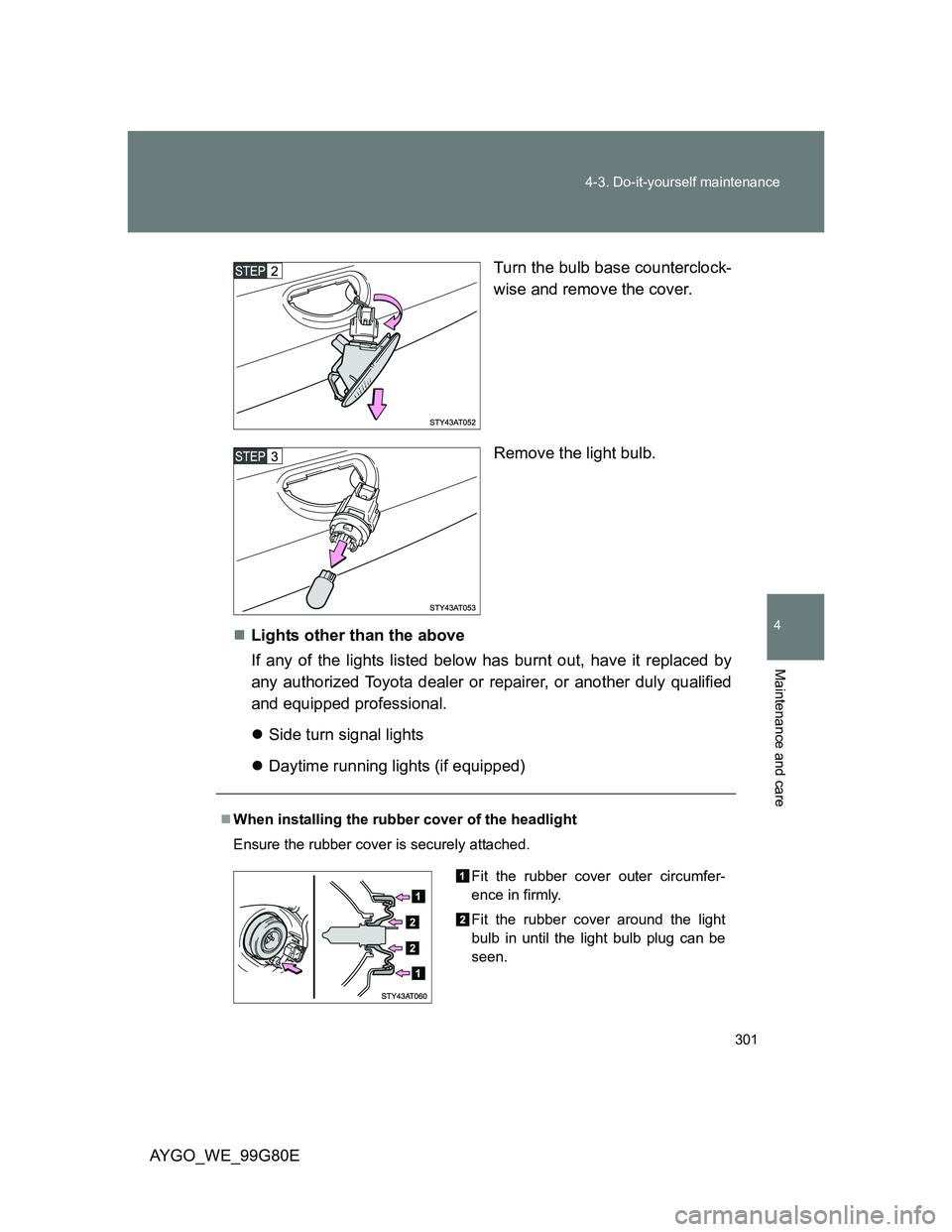
301 4-3. Do-it-yourself maintenance
4
Maintenance and care
AYGO_WE_99G80ETurn the bulb base counterclock-
wise and remove the cover.
Remove the light bulb.
Lights other than the above
If any of the lights listed below has burnt out, have it replaced by
any authorized Toyota dealer or repairer, or another duly qualified
and equipped professional.
Side turn signal lights
Daytime running lights (if equipped)
When installing the rubber cover of the headlight
Ensure the rubber cover is securely attached.
Fit the rubber cover outer circumfer-
ence in firmly.
Fit the rubber cover around the light
bulb in until the light bulb plug can be
seen.
Page 302 of 372
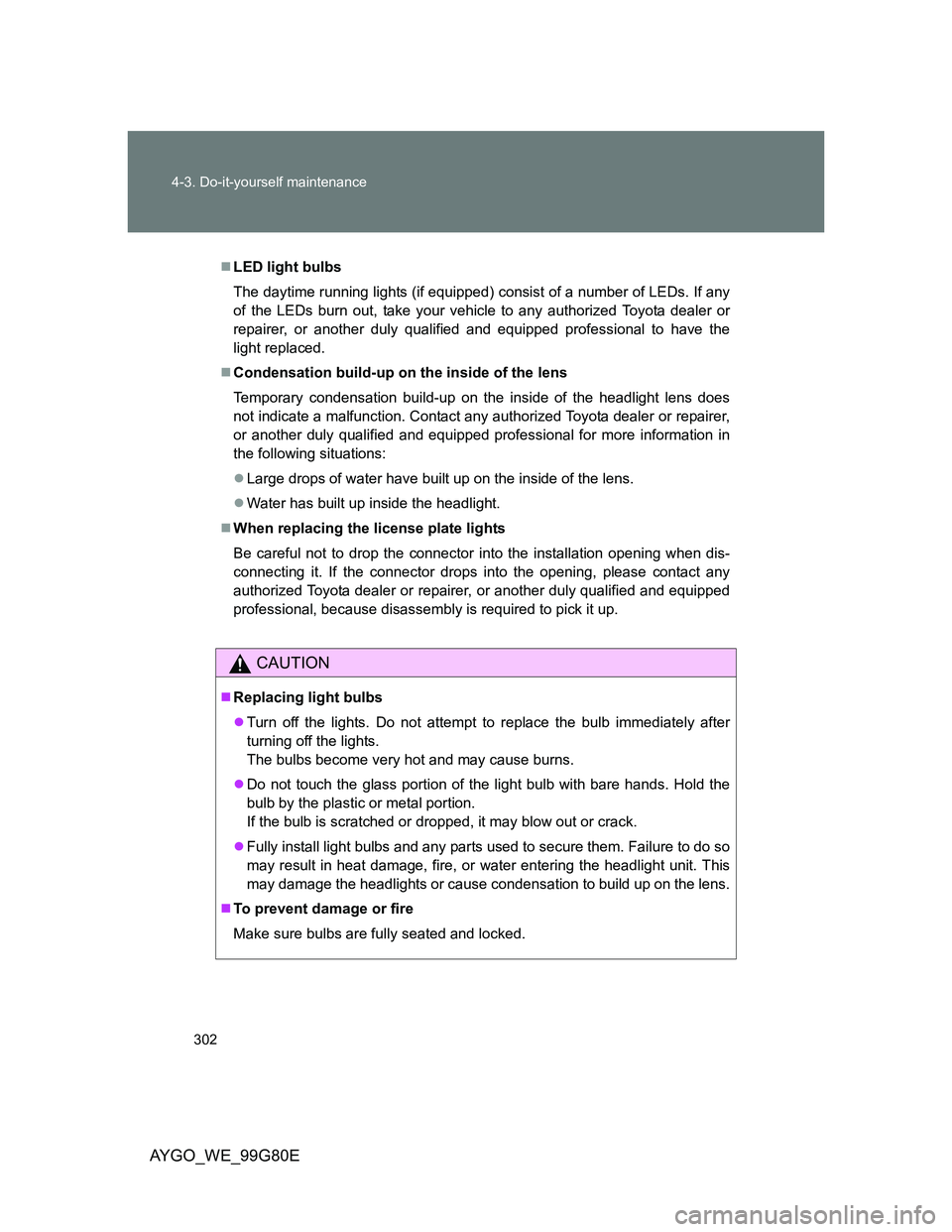
302 4-3. Do-it-yourself maintenance
AYGO_WE_99G80E
LED light bulbs
The daytime running lights (if equipped) consist of a number of LEDs. If any
of the LEDs burn out, take your vehicle to any authorized Toyota dealer or
repairer, or another duly qualified and equipped professional to have the
light replaced.
Condensation build-up on the inside of the lens
Temporary condensation build-up on the inside of the headlight lens does
not indicate a malfunction. Contact any authorized Toyota dealer or repairer,
or another duly qualified and equipped professional for more information in
the following situations:
Large drops of water have built up on the inside of the lens.
Water has built up inside the headlight.
When replacing the license plate lights
Be careful not to drop the connector into the installation opening when dis-
connecting it. If the connector drops into the opening, please contact any
authorized Toyota dealer or repairer, or another duly qualified and equipped
professional, because disassembly is required to pick it up.
CAUTION
Replacing light bulbs
Turn off the lights. Do not attempt to replace the bulb immediately after
turning off the lights.
The bulbs become very hot and may cause burns.
Do not touch the glass portion of the light bulb with bare hands. Hold the
bulb by the plastic or metal portion.
If the bulb is scratched or dropped, it may blow out or crack.
Fully install light bulbs and any parts used to secure them. Failure to do so
may result in heat damage, fire, or water entering the headlight unit. This
may damage the headlights or cause condensation to build up on the lens.
To prevent damage or fire
Make sure bulbs are fully seated and locked.
Page 303 of 372
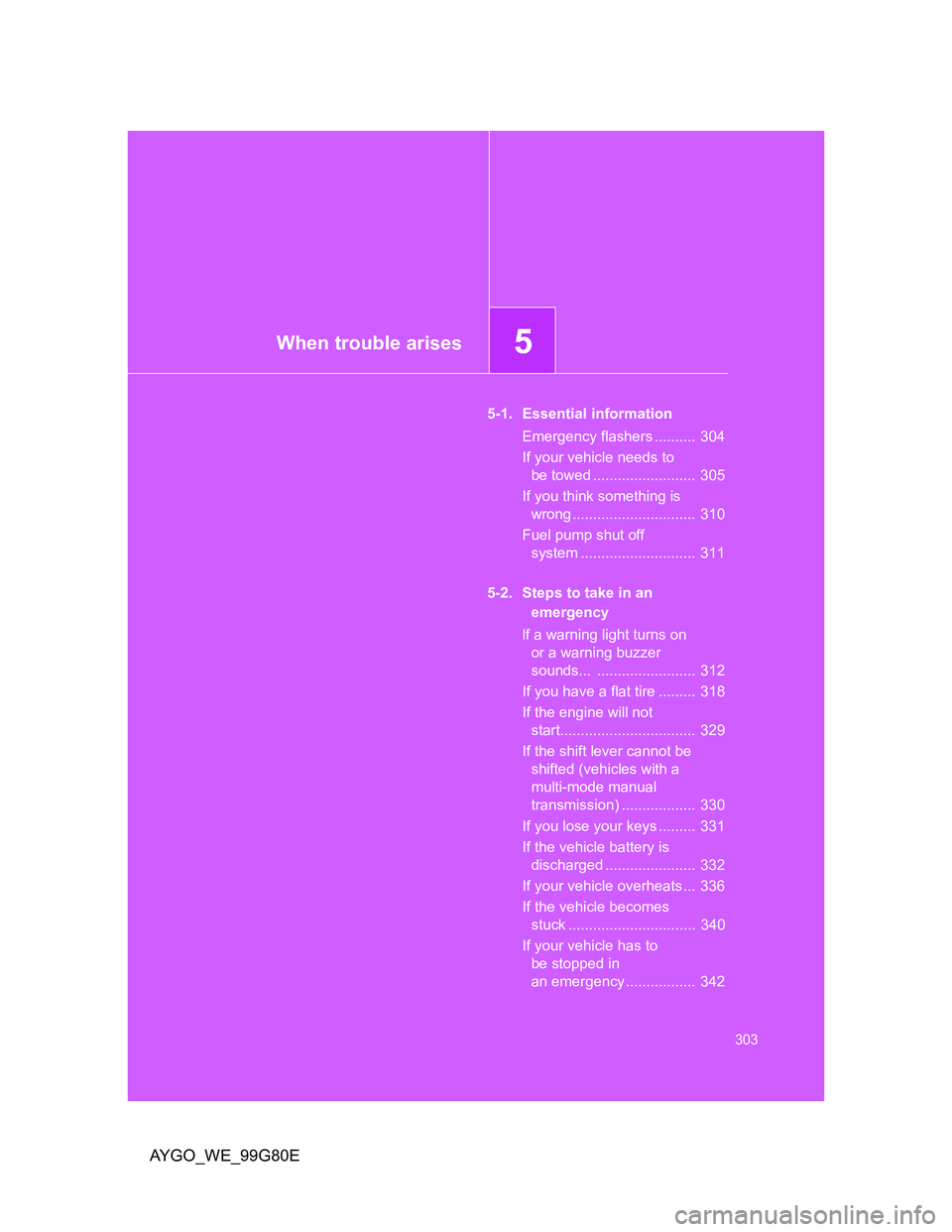
5When trouble arises
303
AYGO_WE_99G80E
5-1. Essential information
Emergency flashers .......... 304
If your vehicle needs to
be towed ......................... 305
If you think something is
wrong .............................. 310
Fuel pump shut off
system ............................ 311
5-2. Steps to take in an
emergency
If a warning light turns on
or a warning buzzer
sounds... ........................ 312
If you have a flat tire ......... 318
If the engine will not
start................................. 329
If the shift lever cannot be
shifted (vehicles with a
multi-mode manual
transmission) .................. 330
If you lose your keys ......... 331
If the vehicle battery is
discharged ...................... 332
If your vehicle overheats ... 336
If the vehicle becomes
stuck ............................... 340
If your vehicle has to
be stopped in
an emergency ................. 342
Page 304 of 372
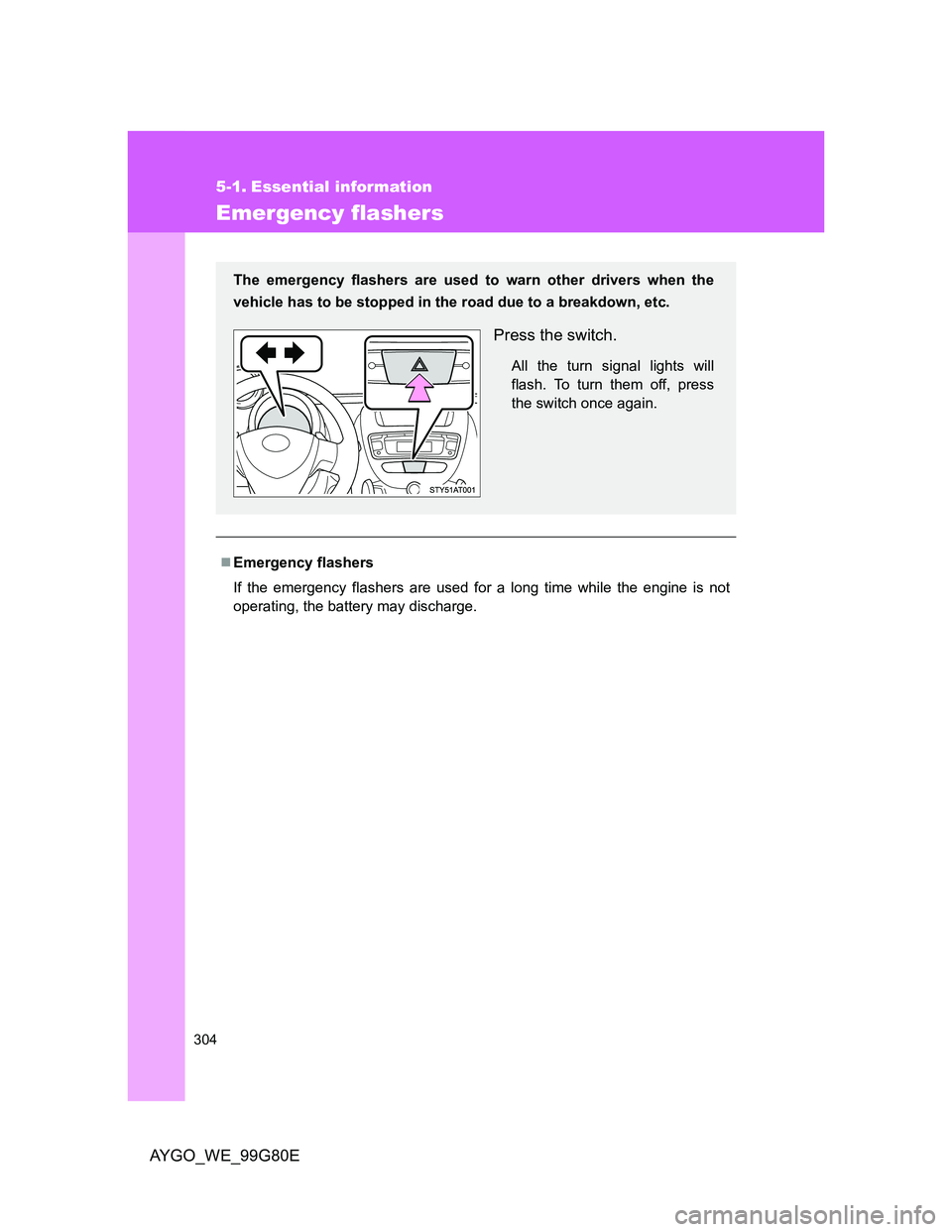
304
AYGO_WE_99G80E
5-1. Essential information
Emergency flashers
Emergency flashers
If the emergency flashers are used for a long time while the engine is not
operating, the battery may discharge.
The emergency flashers are used to warn other drivers when the
vehicle has to be stopped in the road due to a breakdown, etc.
Press the switch.
All the turn signal lights will
flash. To turn them off, press
the switch once again.
Page 305 of 372
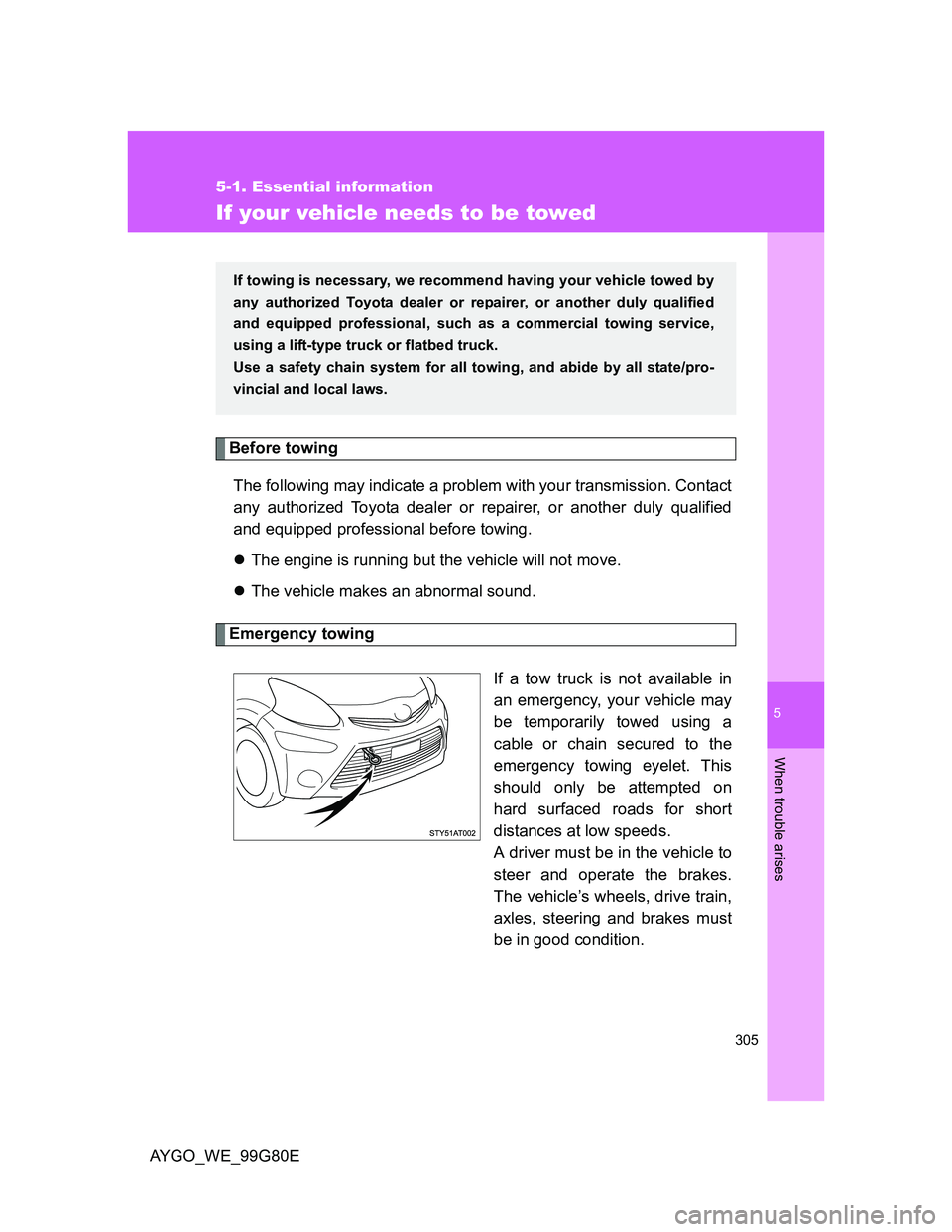
5
305
5-1. Essential information
When trouble arises
AYGO_WE_99G80E
If your vehicle needs to be towed
Before towing
The following may indicate a problem with your transmission. Contact
any authorized Toyota dealer or repairer, or another duly qualified
and equipped professional before towing.
The engine is running but the vehicle will not move.
The vehicle makes an abnormal sound.
Emergency towing
If a tow truck is not available in
an emergency, your vehicle may
be temporarily towed using a
cable or chain secured to the
emergency towing eyelet. This
should only be attempted on
hard surfaced roads for short
distances at low speeds.
A driver must be in the vehicle to
steer and operate the brakes.
The vehicle’s wheels, drive train,
axles, steering and brakes must
be in good condition.
If towing is necessary, we recommend having your vehicle towed by
any authorized Toyota dealer or repairer, or another duly qualified
and equipped professional, such as a commercial towing service,
using a lift-type truck or flatbed truck.
Use a safety chain system for all towing, and abide by all state/pro-
vincial and local laws.
Page 306 of 372
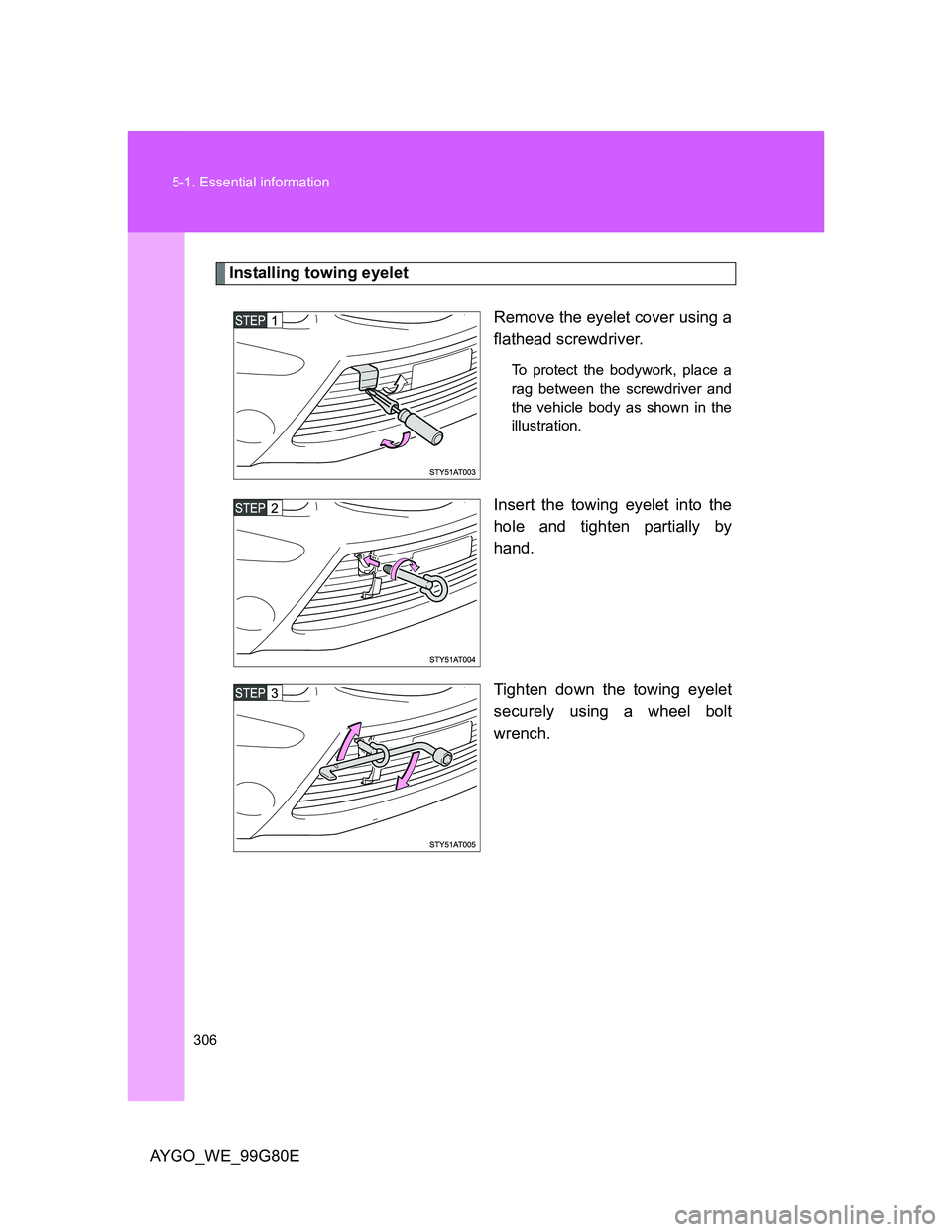
306 5-1. Essential information
AYGO_WE_99G80E
Installing towing eyelet
Remove the eyelet cover using a
flathead screwdriver.
To protect the bodywork, place a
rag between the screwdriver and
the vehicle body as shown in the
illustration.
Insert the towing eyelet into the
hole and tighten partially by
hand.
Tighten down the towing eyelet
securely using a wheel bolt
wrench.
Page 307 of 372
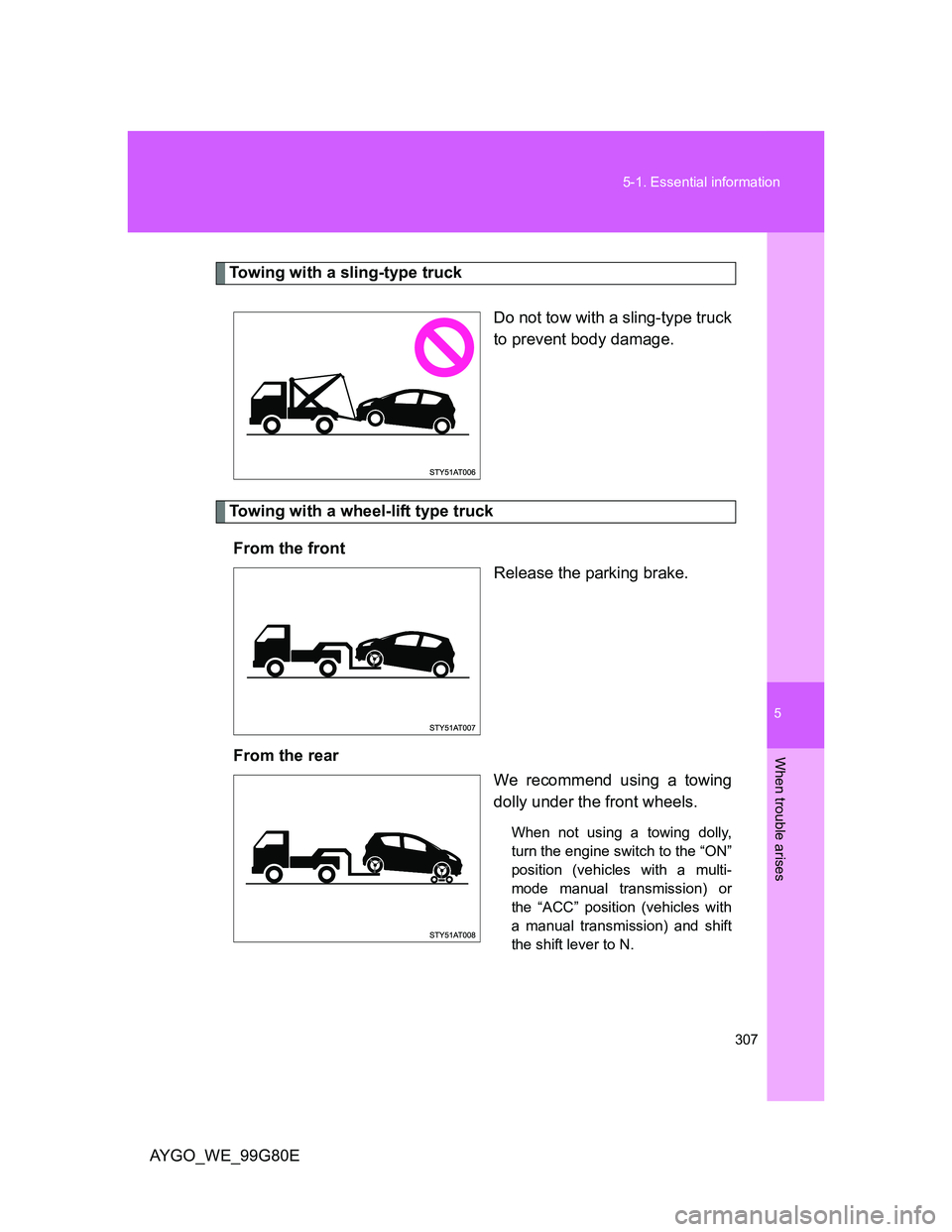
5
307 5-1. Essential information
When trouble arises
AYGO_WE_99G80E
Towing with a sling-type truck
Do not tow with a sling-type truck
to prevent body damage.
Towing with a wheel-lift type truck
From the front
Release the parking brake.
From the rear
We recommend using a towing
dolly under the front wheels.
When not using a towing dolly,
turn the engine switch to the “ON”
position (vehicles with a multi-
mode manual transmission) or
the “ACC” position (vehicles with
a manual transmission) and shift
the shift lever to N.
Page 308 of 372
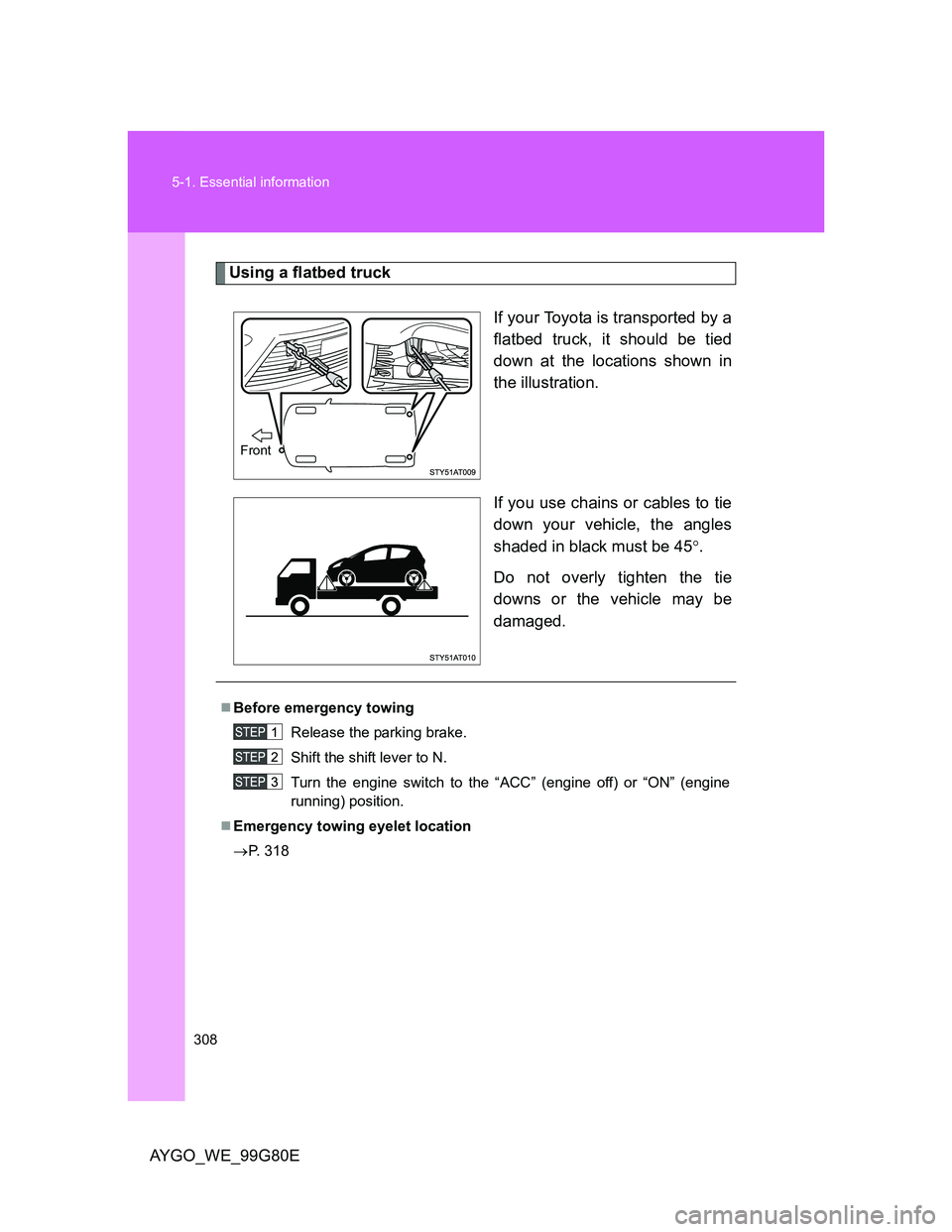
308 5-1. Essential information
AYGO_WE_99G80E
Using a flatbed truck
If your Toyota is transported by a
flatbed truck, it should be tied
down at the locations shown in
the illustration.
If you use chains or cables to tie
down your vehicle, the angles
shaded in black must be 45.
Do not overly tighten the tie
downs or the vehicle may be
damaged.
Front
Before emergency towing
Release the parking brake.
Shift the shift lever to N.
Turn the engine switch to the “ACC” (engine off) or “ON” (engine
running) position.
Emergency towing eyelet location
P. 318
Page 309 of 372
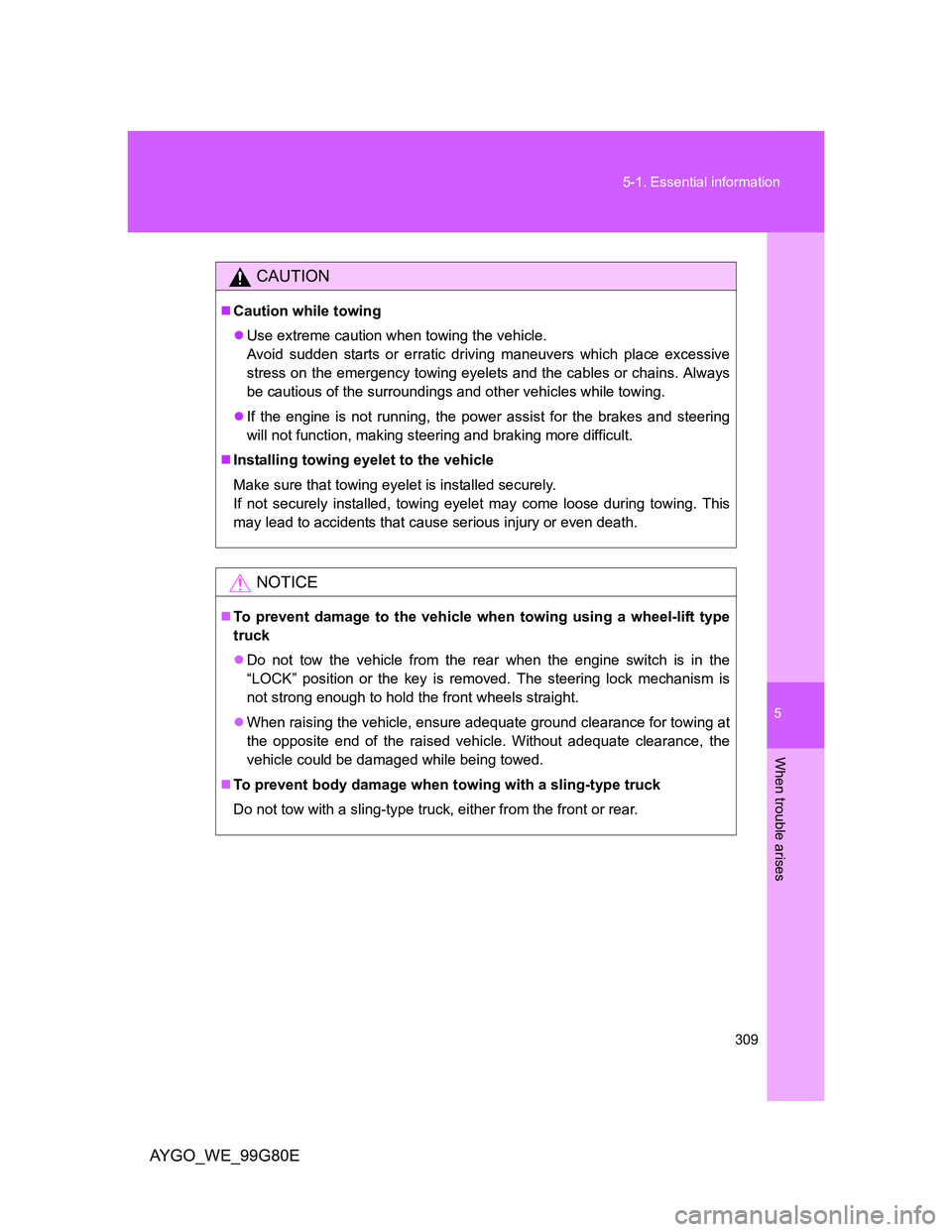
5
309 5-1. Essential information
When trouble arises
AYGO_WE_99G80E
CAUTION
Caution while towing
Use extreme caution when towing the vehicle.
Avoid sudden starts or erratic driving maneuvers which place excessive
stress on the emergency towing eyelets and the cables or chains. Always
be cautious of the surroundings and other vehicles while towing.
If the engine is not running, the power assist for the brakes and steering
will not function, making steering and braking more difficult.
Installing towing eyelet to the vehicle
Make sure that towing eyelet is installed securely.
If not securely installed, towing eyelet may come loose during towing. This
may lead to accidents that cause serious injury or even death.
NOTICE
To prevent damage to the vehicle when towing using a wheel-lift type
truck
Do not tow the vehicle from the rear when the engine switch is in the
“LOCK” position or the key is removed. The steering lock mechanism is
not strong enough to hold the front wheels straight.
When raising the vehicle, ensure adequate ground clearance for towing at
the opposite end of the raised vehicle. Without adequate clearance, the
vehicle could be damaged while being towed.
To prevent body damage when towing with a sling-type truck
Do not tow with a sling-type truck, either from the front or rear.
Page 310 of 372
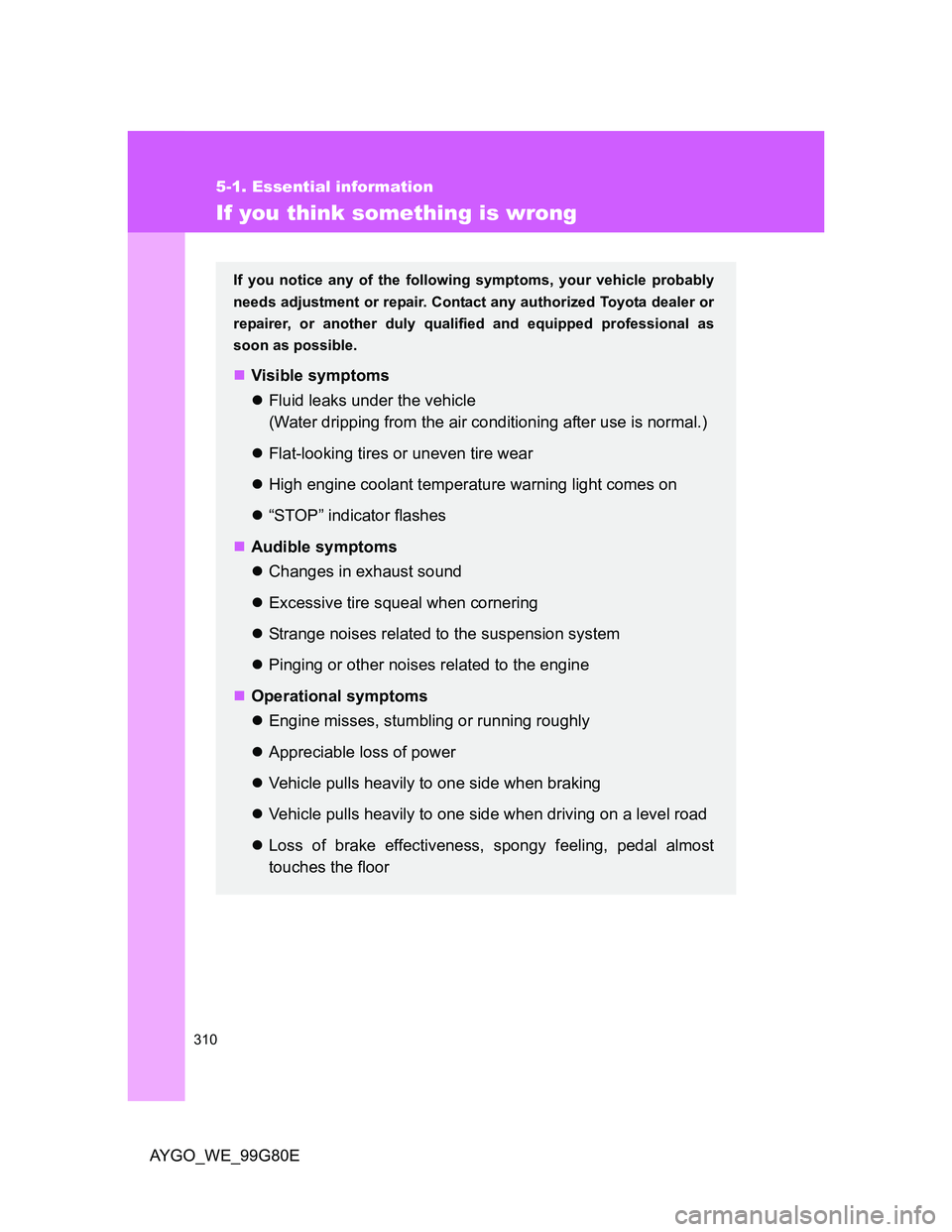
310
5-1. Essential information
AYGO_WE_99G80E
If you think something is wrong
If you notice any of the following symptoms, your vehicle probably
needs adjustment or repair. Contact any authorized Toyota dealer or
repairer, or another duly qualified and equipped professional as
soon as possible.
Visible symptoms
Fluid leaks under the vehicle
(Water dripping from the air conditioning after use is normal.)
Flat-looking tires or uneven tire wear
High engine coolant temperature warning light comes on
“STOP” indicator flashes
Audible symptoms
Changes in exhaust sound
Excessive tire squeal when cornering
Strange noises related to the suspension system
Pinging or other noises related to the engine
Operational symptoms
Engine misses, stumbling or running roughly
Appreciable loss of power
Vehicle pulls heavily to one side when braking
Vehicle pulls heavily to one side when driving on a level road
Loss of brake effectiveness, spongy feeling, pedal almost
touches the floor